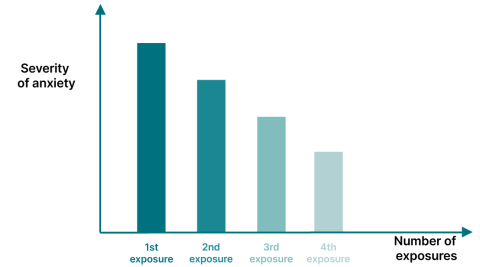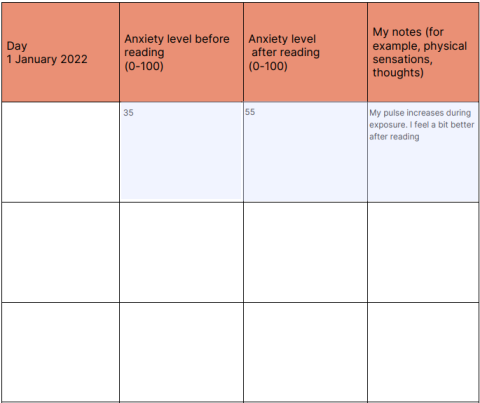Self-help program
4. Learn to face your fears
Many people try to reduce their level of concern by controlling their worrying thoughts. You might say to yourself: “I’m not going to think about this anymore. I have to stop worrying and think more positively.”
However, the worry is likely to push its way into your mind again quite quickly. There is no point in denying or avoiding emotions, needs and conflicts. This struggle will cause a burden on your mental health in the same way as dwelling on them.
Why doesn’t avoidance help?
Thought exercise (elephant)
Goal
In this exercise you will notice that what you’re trying to avoid keeps intruding into your mind.
Instructions
For the next 60 seconds, try to think about anything except a pink elephant. Think about anything at all, but don’t think about a pink elephant. Don’t think about what it looks like, don’t even think about the words “pink elephant”.
Set a timer to ring in one minute. Start now.
Were you successful? You probably noticed yourself thinking about a pink elephant much more often than you normally would during the 60-second period.
Exposing yourself to anxiety
Instead of avoiding difficult thoughts, you can decrease anxiety and fear by exposing yourself to the situations and thoughts that cause these feelings. It’s a good idea to do this exposure safely, in small steps and repetitively. Exposure may seem scary at first, but in the long run the practice will decrease your sense of fear and the need for avoidance.
The purpose of exposure is to gradually experience and learn about your ability to cope in these situations. It’s important to progress at a sufficiently slow pace to keep the feeling of anxiety at a manageable level.

Avoidant behavior is a natural response when experiencing anxiety. It is still important to become aware of it, because avoidance increases anxiety in the long run.
In the video (1:20), leading psychologist Jan-Henry Stenberg explains what exposure is all about.
Exercise: Exposure – Describing fear
Goal
To notice that going through your worst fears in your imagination is not as dangerous as you thought.
Instructions
This exercise consists of two parts:
- making a detailed description of the imagined fear
- exposure to images
In both parts exposure takes place at the imagery level.
1: A detailed description of the fear
In this first part create a very detailed image of your greatest fear and concretely describe how it could happen. Write a detailed description. Describe in detail, what would be the worst thing, that could happen and what could it result in.
Consider:
- What happens in your imagined fear?
- How do you feel?
- What thoughts do you have in the situation and how do you act?
- What do you hear and smell?
2: Exposure to images
Instructions
A. Practice exposure to images by reading out loud about your fear and by writing down your level of anxiety.
Read the description of you fear out loud, 1-3 times a day. Do this for at least three days in order to accustom yourself to this fear thought. You can also record your description on your mobile phone for example, and listen to your recording instead.
This is a challenging task and will probably cause unpleasant feelings at the beginning. However, the fear-related feeling will gradually ease as a result of repetition and from reading the description out loud.
B. At the same time, your task is also to keep a record of the exposure exercise using the journal provided here.
We recommend that you do the exercise independently, for example in the notes of your mobile phone, in a notebook or in a pdf template, which you can find at the end of this excercise.
An example of the questions and a picture of the structure of the diary
Anxiety level before reading (0–100): 35
Anxiety level after reading (0–100): 55
My notes: For example, physical sensations and thoughts like "My pulse increases during exposure. I feel a bit better after reading.".

Remember
Avoidance is an ineffective way of managing anxiety.
